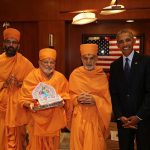ISKCON: Establishment Day: July 13, 1966
The International Society for Krishna Consciousness (ISKCON) is a worldwide affiliation of bhakti-yoga practitioners. Though relatively new to the western world, Krishna consciousness is at the heart of India’s timeless spiritual culture. For anyone looking beyond what this temporary, limited world has to offer, ISKCON is what the Chamber of Commerce is for those looking to get ahead in business.
About His Divine Grace A.C. Bhaktivedanta Swami Prabhupada
The International Society for Krishna Consciousness (ISKCON) is a branch of the monotheistic Gaudiya Vaishnava tradition within Hinduism dating back 5000 years to Lord Krishna Himself. ISKCON was established in the West in 1966 by His Divine Grace A.C. Bhaktivedanta Swami Prabhupada (Srila Prabhupada) and has since developed into a worldwide confederation of over 500 temples, centers, communities, schools, and restaurants with some 250,000 devotees.

The mission of this nonsectarian, monotheistic movement is to promote the well-being of society by teaching the science of Krishna consciousness according to Bhagavad-gita and other ancient scriptures.
His Divine Grace A.C. Bhaktivedanta Swami Prabhupada (1896-1977), the founder-acharya* of the International Society for Krishna Consciousness(ISKCON), was the foremost proponent and teacher of Krishna consciousness—devotional service to the Supreme Person, Krishna—of the late twentieth century.
Srila Prabhupada, as he’s known to his followers, translated and commented on over eighty volumes of the most important sacred bhakti texts. His books include Bhagavad-gita As It Is—the definitive commentary on Krishna’s advice on how to be happy in this life and the next, and the multi-volume Srimad-Bhagavatam—a history of Krishna’s activities, His avatars, and His many devotees throughout the universe. Srila Prabhupada also constantly travelled the world, initiating thousands of disciples and managing a global spiritual movement which continues to grow today.
When Srila Prabhupada met his own spiritual master, Srila Bhaktisiddhanta Sarasvati Thakur in 1922, Srila Bhaktisiddhanta urged the young devotee later known as Srila Prabhupada to preach Chaitanya Mahaprabhu‘s message of Krishna consciousness in English.
Seven Purposes of ISKCON
His Divine Grace A.C. Bhaktivedanta Swami Prabhupada incorporated the International Society for Krishna Consciousness in 1966 with seven explicit purposes.
This list of purposes (below) was one of the official documents incorporating ISKCON as a charitable organization. At the time, the movement had few followers in the West and was operating out of a rented storefront in New York City. One of the pressing needs at the time was to facilitate donors who wanted to give tax-deductible donations to establish a temple for Lord Krishna in New York City.
In the years that followed, Srila Prabhupada expanded ISKCON’s mission and activities beyond some of the details listed in the incorporation documents, while remaining consistent with its principles. For example, ISKCON has established many more than one “holy place of transcendental pastimes dedicated to the personality of Krishna”, with temples in major cities around the world. “To bring the members closer together for the purpose of teaching a simpler, more natural way of life”has inspired the development of self-sufficient farm communities, ashrams and spiritual retreat centers.
Srila Prabhupada’s plan to re-spiritualize society through the distribution of sanctified food is not mentioned in the original incorporation documents. Yet he established Food For Life and Govinda’s vegetarian restaurants, and the Sunday Feast has become the weekly happening at every ISKCON center.
- To systematically propagate spiritual knowledge to society at large and to educate all people in the techniques of spiritual life in order to check the imbalance of values in life and to achieve real unity and peace in the world.
- To propagate a consciousness of Krishna (God), as it is revealed in the great scriptures of India, Bhagavad-gita and Srimad-Bhagavatam.
- To bring the members of the Society together with each other and nearer to Krishna, the prime entity, thus developing the idea within the members, and humanity at large, that each soul is part and parcel of the quality of Godhead (Krishna).
- To teach and encourage the sankirtana movement, congregational chanting of the holy name of God, as revealed in the teachings of Lord Sri Caitanya Mahaprabhu.
- To erect for the members and for society at large a holy place of transcendental pastimes dedicated to the personality of Krishna.
- To bring the members closer together for the purpose of teaching a simpler, more natural way of life.
- With a view towards achieving the aforementioned purposes, to publish and distribute periodicals, magazines, books and other writings.
Courtesy : http://www.krishna.com












